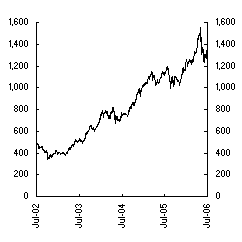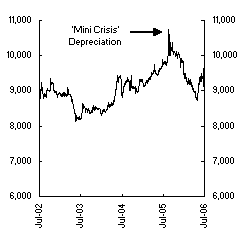Milovan Lucich, Nathan Dal Bon and Elisha Houston2
Boxing Day 2005 marked the first anniversary of the tsunami that devastated communities in Indonesia, Thailand, Sri Lanka, India and as far away as the east coast of Africa, leaving an estimated 230,000 people dead and 1.7 million displaced. Australia has provided substantial assistance to the tsunami-affected countries, with the main focus of our effort on one of our nearest and largest neighbours,Indonesia. The $1billion3 Australia-Indonesia Partnership for Reconstruction and Development (AIPRD), announced by Prime Minister Howard on 10January2005, is the single-largest aid package in Australia’s history. The Australian Treasury has worked with the Australian Agency for International Development (AusAID) and other Australian Government agencies to develop and implement the AIPRD, and the Treasurer is one of the five Australian and Indonesian Ministers on the AIPRD Joint Commission.
The first part of this paper focuses on how the Indonesian economy has performed in recent times, particularly since the tsunami, and discusses the reform priorities of the current Indonesian Government. The second part provides some information on the work Treasury is doing with Indonesian counterpart agencies under the AIPRD’s Government Partnership Fund (GPF).
Introduction
The Republic of Indonesia is located in the Asian Archipelago, the world's largest archipelago; its 18,108 islands cover five million square kilometres between Indochina and Australia and the Indian and Pacific Oceans. Indonesia is the most populous Muslim-majority country in the world and the fourth most populous overall with a population of over 220 million.
The 2004 Indian Ocean earthquake, which had a magnitude of 9.2 on the Richter scale, triggered a tsunami on 26 December 2004 that killed approximately 230,000 people (more than 168,000 in Indonesia alone), making it the deadliest tsunami in recorded history. The tsunami killed people over an area ranging from the immediate vicinity of the quake in Indonesia, Thailand and the north-western coast of Malaysia, to thousands of kilometres away in Bangladesh, India, Sri Lanka, the Maldives, and even as far as Somalia, Kenya and Tanzania in eastern Africa.
The disaster prompted a huge worldwide effort to help victims of the tragedy, with billions of dollars being raised for disaster relief. Australia was at the forefront of this relief effort. In addition to the generosity of private citizens, Prime Minister Howard announced the $1 billion Australia-Indonesia Partnership for Reconstruction and Development (AIPRD) on 10 January 2005. The AIPRD is significant not only in terms of its absolute size but also for the new approach to bilateral aid that it represents.
The AIPRD is a genuine partnership, jointly overseen by Indonesian and Australian Ministers. It focuses on both immediate reconstruction priorities and Indonesia’s broader long-term development challenges. It recognises the importance of sound institutions to successful development and, through the $50 million Government Partnership Fund (GPF), fosters closer working partnerships between Australian and Indonesian officials in support of the latter’s reform efforts.
The tsunami followed a period of significant change and upheaval in Indonesia, including the fall of the Suharto regime, the transition to democracy, and the Asian financial crisis. After providing a brief overview of the Indonesian economy, the following section examines economic developments in Indonesia in recent years, focusing on the period following the tsunami, before detailing Treasury’s engagement activities with its counterparts in Indonesia.
Economic developments in Indonesia
Indonesia has a market-based economy in which the government plays a significant role. It owns more than 164 state enterprises and administers prices of several basic goods, including fuel, rice, and electricity. Manufacturing accounts for 28percent of Indonesia’s gross domestic product (GDP), services 41 per cent and agriculture 15percent (agriculture employs over 40 per cent of the labour force). Crude oil and natural gas are Indonesia’s most valuable natural resources and have long been its major source of export revenue, but growth in domestic oil demand, together with declines in production since the 1990s, contributed to the nation becoming a net importer of oil in 2004 and 2005.
During the decades leading up to the 1997-1998 Asian financial crisis, Indonesia shared in the sustained economic growth that was enjoyed by much of East Asia. Real annual GDP growth averaged 7.2 per cent from 1977 to 1996, lifting 30 million Indonesians out of poverty over this period.
The crisis, however, had more severe effects in Indonesia than in any other country in the region. Indonesia’s real GDP fell by 13.1 per cent in 1998 (18 per cent through-the-year to December 1998, see Chart 1) as bank failures, capital flight and disorder took hold in the financial sector. The investment environment deteriorated to such an extent that Indonesia’s modern, labour-intensive manufacturing sector was severely undermined.
Chart 1: Real GDP growth (through-the-year)
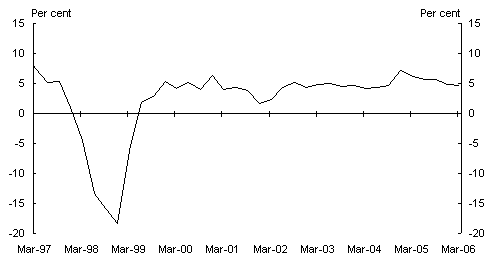
Source: CEIC Asia Database.
As a consequence, Indonesia sought assistance from the International Monetary Fund (IMF), as well as receiving bi-lateral support from a number of countries. Australia and Japan were the only countries in the region to contribute to all three IMF packages to the crisis-affected economies of Korea, Thailand and Indonesia.4
Indonesia’s subsequent recovery has been slower than those of other crisis-affected countries in the region, with poverty and unemployment remaining stubbornly high. The country only regained pre-crisis levels of real GDP in 2003, and real per capita GDP did not recover to pre-crisis levels until early 2005. Indonesia’s GDP per capita (measured on a purchasing-power-parity basis) was US$4,458 in 2005, compared with US$30,897 for Australia.
Despite slower growth than its neighbours since the crisis, Indonesia’s economy remains the largest in South East Asia, accounting for almost half of the ASEAN-4’s aggregate GDP (see Chart 2).
Chart 2: ASEAN-4 GDP comparison at PPP (2005)
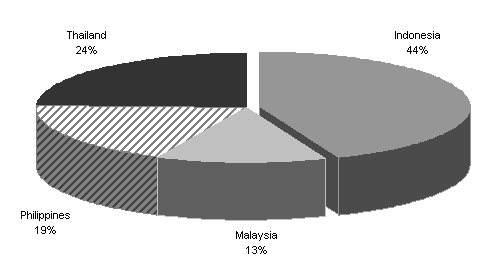
Source: IMF World Economic Outlook Database, April 2006.
The relatively slow recovery in Indonesia reflected the scale and complexity of its economic challenges as well as the lack of political consensus on how best to deal with them. After the resignation of President Suharto in 1998, it was not until the Megawati Government (2001-2004) that the authorities were able to restore macroeconomic and financial stability. However, the much-needed recovery in investment has taken longer to materialise, due partly to weaknesses in Indonesia’s regulatory framework and legal system, as well as gaps in its physical infrastructure. The current Government, led by President Susilo Bambang Yudhoyono, which took office in October 2004, has taken steps to strengthen the reform agenda and has made addressing institutional weaknesses one of its key priorities (see reform agenda section below for further details).
Recent economic performance
Economic growth
Economic growth has slowly gained momentum over the years following the Asian financial crisis, increasing from 3.8 per cent in 20
01 to 5.1 per cent in 2004 and 5.6percent in 2005 — the fastest annual rate of growth since the crisis. The composition of growth has also changed, with a welcome rebalancing from consumption to investment. Investment grew by around 15percent in 2004 compared with 0.6 per cent in the previous year, assisted by a recovery in foreign direct investment (see Charts 2 and 3).
More recently, economic growth and investment have begun to slow, with investment weakening again in the second half of 2005. Overall, investment growth for 2005 declined to 9.9 per cent, partly due to a financial ‘mini crisis’, which is discussed further below. As a result, the ratio of investment to GDP, which had been moving back towards pre-crisis levels of 25-30 per cent, has now declined to around 22percent.
Chart 3: Contributions to GDP growth
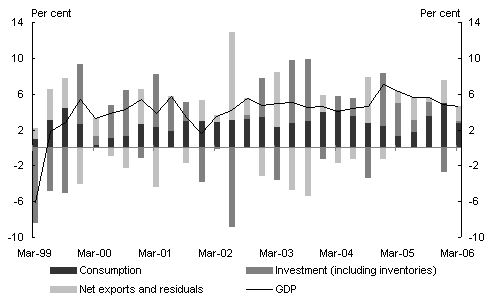
Source: CEIC Asia Database.
Notwithstanding the terrible cost in human lives and damage to infrastructure and homes in the province of Nanggroe Aceh Darussalam (Aceh), the tsunami had only a small impact on Indonesia’s economic growth in 2005. This reflected the fact that Aceh accounts for only 2 per cent of Indonesia’s GDP, and that the reduced agricultural production in the region has been largely offset by reconstruction spending.5
According to a World Bank study, the direct impact of the tsunami lowered the national GDP growth rate by 0.1-0.4 percentage points in 2005. The Bank concluded that, when the offsetting effects of reconstruction activities were taken into account, the net economic impact of the tsunami on nationwide growth in Indonesia was likely to be close to zero.6
Chart 4: Foreign direct investment7
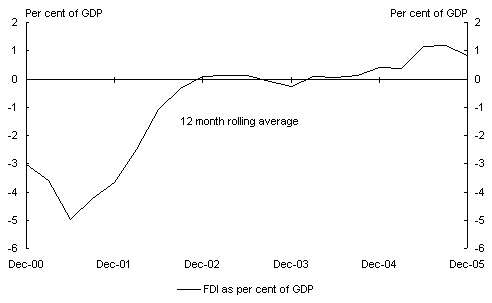
Source: CEIC Asia Database.
August 2005 ‘mini crisis’
Despite strong growth in the first half of 2005, last year proved to be a testing year for the Indonesian authorities. In August, the Indonesian rupiah and stock market both fell sharply, reflecting concerns in financial markets about the impact of higher oil prices on Indonesia’s public finances and external financial position8 (see Charts 4 and5). The Government responded to the ‘mini crisis’ with a policy package on 1October2005, including a large increase in domestic fuel prices. The reduction in fuel subsidies led to domestic fuel prices increasing by an average of 114per cent. Budgetary savings from the fuel price rise in 2005 are estimated at approximately 0.5per cent of GDP and could amount to up to 2.5 per cent of GDP in 2006, depending on international oil prices.9
The reduction in fuel subsidies, together with Bank Indonesia’s lifting of official interest rates from 8.75percent in August 2005 to a peak of 12.75 per cent in December2005, led to the stabilisation of financial markets. Since the peak of the crisis in August 2005, the exchange rate has appreciated by 10.5 per cent and the stock market has risen by 34.7per cent.
|
Chart 5: Jakarta composite index |
Chart 6: Rupiah per $US |
|
|
|
Source: CEIC Asia Database, Datastream.
At the same time the Indonesian Government commenced the unwinding of fuel subsidies, it also announced a compensation package for the poor. Under the Indonesian Government’s oil price compensation arrangements, around 15.5 million poor households are being allocated an ongoing cash transfer of 100,000 rupiah (around US$9 at July 2006 exchange rates) per month distributed quarterly.
Reflecting the unwinding of fuel subsidies and higher interest rates, economic growth slowed in the latter part of 2005. This trend has continued into the first half of 2006, with GDP growth slowing to 4.6 per cent in the March quarter. Looking forward, economic growth is expected to strengthen, due in part to stronger Government expenditure. Overall, Consensus Forecasts expects growth of 5.2per cent in 2006, down from 5.6 per cent growth in 2005.
Inflation and interest rates
While inflation has fallen substantially in the years following the 1997-98 crisis, the unwinding of fuel subsidies in October 2005 saw inflation rise sharply, with inflation peaking in November at over 18 per cent through-the-year (see Chart 6). In the first half of 2006, inflation has moderated to some extent, with the CPI rising by 15.5percent through the year to June 2006. It is expected to decline further through the second half of the year as the subsidies reductions pass through. Consensus Forecasts expects average inflation of 13.3 per cent for the year.
The decline in inflation has enabled Bank Indonesia to relax monetary policy settings, with official interest rates reduced in May and June this year to the current rate of 12.25per cent. The reduction in interest rates should assist the banking sector, which came under pressure during the August ‘mini-crisis’. In the second half of 2005, loan growth decelerated and the net non-performing loan ratio rose from 1.9 per cent to 5.0per cent. In particular, State-owned commercial banks reported non-performing loan ratios of around 15percent, up from 5.5 per cent in 2004.
Chart 7: CPI and real interest rate
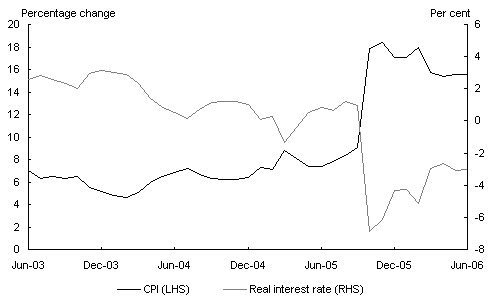
Source: CEIC Asia Database.
External sector
In 2005, Indonesia’s current account surplus fell to US$3 billion or 1.1 per cent of GDP, compared with a surplus of 4.8 per cent of GDP in 2000. In value terms, total merchandise exports rose by around 20 per cent in 2005. However, in volume terms, export growth was flat. At the same time, merchandise imports rose by about 26percent in value terms in 2005.
In recent years, Indonesia has experienced a significant slowdown in the growth of exports in sectors where it traditionally has had a comparative advantage, including furniture, palm oil, rubber, textiles, and footwear. This has led to concerns that Indonesia has been losing trade competitiveness, particularly to China and Vietnam, through persistent inflation, rising labour costs and a relatively strong currency. The IMF estimated in 2004 that Indonesian unit labour costs were about 35 per cent higher in dollar terms than before 1997. Generally weak investment in recent years has also hampered Indonesia’s competitiveness. This applies not only to a lack of investment in manufacturing, but also in transportation, ports, and other infrastructure that affects exporters’ costs.
Government sector
Indonesia has significantly improved its fiscal situation in recent years, with the central government budget deficit narrowing from 2.4 per cent of GDP in 2001 to 0.5 per cent in 2005. The outcome last year was helped by the cuts in fuel subsidies and delays in spending caused by changes to budge
tary procedures.10 The deficit is expected to widen to 1.2 per cent in 2006, primarily reflecting spending carryovers from 2005.
On the revenue side, the Indonesian Government is making a concerted effort to improve tax compliance and more generally to reform the tax system. The system has a limited capacity to raise revenue due to a very large informal sector (in a country of around 220 million people there are only 10 million registered income tax payers).11 In2005, total tax revenue amounted to only 12.8 per cent of Indonesia’s GDP — a low figure compared with other developing countries.
Fiscal consolidation and solid GDP growth have reduced the central government debt to GDP ratio from around 100percent in 2000 to close to 50 per cent in 2005. The ratio of external public debt to GDP has also steadily declined in recent years, from about 45percent in 2000 to 27 per cent in 2005. As part of the international response to the tsunami, Australia joined with other Paris Club members to delay debt repayments from Indonesia, allowing it to focus resources on emergency and reconstruction efforts.12
Economic policy and the reform agenda in Indonesia
Despite experiencing some major challenges last year, Indonesia’s short-term growth prospects remain positive. However, to significantly reduce rates of poverty and unemployment, economic growth needs to be increased. Poverty is widespread, with half of the population surviving on less than US$2 a day. While at current growth rates the economy is adding a net 1.2 to 1.4 million jobs a year, 1.6 to 1.8 million new workers are entering the workforce each year. In 2005 the unemployment rate was 10.3percent, more than double its pre-crisis level of 4.7 per cent in 1997. Inroads into Indonesia’s unemployment and poverty rates will not be achieved unless economic growth of greater than 6percent per annum is sustained.
The Indonesian Government has detailed a three-pillared approach to reduce rates of poverty and unemployment.13
- Increase confidence in economic stability by significantly reducing the inflation rate through Bank Indonesia’s inflation targeting regime. Last year’s ‘mini-crisis’ was an early test of this regime, which was first adopted in 2005. The inflation target for 2006 is 7-9 per cent. This was raised from the previous target of 5-7percent as a result of the further reduction in fuel subsidies.
- Lift economic growth above 6 per cent by making further progress on a range of structural reforms. These include:
- reforms to taxation arrangements, including the gradual reduction of the corporate tax rate, addressing problems in tax administration, and reducing trade and business distorting regional taxes;
- reforms to the financial sector, as announced on 5July2006 in the Financial Sector Reform Package, including: strengthening coordination between fiscal and monetary authorities; regulatory changes to enable the state-owned banks to offload their non-performing loans; and measures to improve the liquidity, efficiency and integrity of the capital markets; and
- reforms to improve the flexibility of the labour market.
- Promote greater private investment, including through: mobilising finance for infrastructure development; and strengthening the rule of law and streamlining government regulations14. Indonesia has an ambitious investment agenda, with investment needs in infrastructure alone estimated at US$63 billion over the next five years.15 However these targets have not been realised and little progress has been made on the numerous infrastructure measures announced by the Government.
Indonesia’s reform and development priorities will not be achieved without strong, effective and responsive policy-making institutions. The improvement and strengthening of the institutions of economic policy development and governance in Indonesia is the main focus of Treasury’s engagement with Indonesia, as detailed below.
Treasury’s engagement with Indonesia
Engagement with Indonesia and the new aid paradigm
The Indonesian public service is generally well educated and dedicated. However, like much of Indonesia, it is going through a period of transition from the poor governance practices that characterised the Suharto era to a public service able to support the Government’s reform agenda.16 It is in this area that Australian Government agencies are well placed to share their experiences of reform and change management with their Indonesian counterparts.
In the past, Australia’s development assistance to Indonesia and other developing countries was primarily provided through conventional AusAID programmes that focused on the provision of basic services to meet humanitarian, health and education needs. However, there has been growing recognition that such efforts alone will not be enough to break the cycle of poverty and deliver sustainable increases in growth.
Experience has demonstrated that one of the key building blocks of sustained economic growth is good governance, based on strong domestic institutions. The Australian Government’s 1997 review of Australia’s aid programme, Better Aid for a Better Future, established governance as one of the five priorities of the aid programme.17
This message has been reaffirmed by the Government’s recent Aid White Paper18, which emphasises the links between good governance, economic growth and poverty reduction. In particular, the paper refers to economic growth being underpinned by ‘appropriate and effective institutions’.
‘Institutions that provide dependable property rights, manage conflict, establish macroeconomic stability, align economic incentives with social benefits and maintain law and order, are an important foundation for long-term growth.’19
Treasury’s engagement activities
In recent years, Treasury has been deepening its engagement with its counterparts throughout the region. It is well known that Treasury has been providing assistance to Papua New Guinea, the Solomon Islands and Nauru, through the placement of Treasury officers in these countries. However, Treasury’s efforts to promote sound economic policy elsewhere in the region are less well known.
Treasury is pursuing a number of policy support activities to build capacities of partner agencies in critical reform areas where Treasury is uniquely placed to contribute. Treasury’s contributions focus on institution building, through the development of high-level policy-making skills and sharing central agency policy perspectives. For example, Australia has been at the forefront of a number of Asia-Pacific Economic Cooperation (APEC)-led initiatives to strengthen governance in key areas such as financial markets and the public sector. In February 2005, Treasury organised a conference attended by officials and academics from throughout the region to discuss key macroeconomic policy and structural policy challenges facing East Asia.20 Treasury has also helped organise an intensive one-month fiscal management course for Indonesian and Chinese officials, with the first group of students completing the course in March 2006.
Treasury has also built linkages at the operational level with its counterparts fro
m the region. For example: in late 2005 Treasury hosted three Indonesian Ministry of Finance (IMoF) officials for a one month internship; Treasury’s Domestic Economy Division are hosting officials from Indonesia and Thailand in the later half of 2006, to further develop their forecasting skills; and Treasury’s International Economy Division will be jointly organising with the Australian National University, the second bi-annual FiscalPolicyCourse for Chinese and Indonesian Officials in September 2006.
These initiatives have not only assisted regional policy makers; they have also deepened Australia’s understanding of key regional economies and developed the skills and capacities of Treasury officers in Australia.
The Australia-Indonesia Partnership
The AIPRD has added a new dimension to Treasury’s efforts to promote improved economic governance in the region. This programme has given Treasury the opportunity to deepen its relationship with the IMoF and other Indonesian agencies, further its understanding of Indonesia’s reform challenges, and foster the development of close working relationships with Indonesian officials.
The AIPRD is guided by a Joint Ministerial Commission, comprising the foreign and economic ministers from both countries and overseen by PrimeMinister Howard and President Yudhoyono. The Commission sets broad strategic directions and establishes priorities for AIPRD funding. The Australian end of the AIPRD Commission is supported by a Secretaries’ Committee, which prepares AIPRD initiatives for ministerial approval. The Committee is comprised of the Secretaries of the Department of Foreign Affairs and Trade, Department of Finance and Administration, Treasury and Department of the Prime Minister and Cabinet.
Projects under the AIPRD are financed through a $500million grant assistance programme and a $500million loan programme. The loan programme is highly concessional as it is interest free and repayments will be made over 40 years, with a 10-year grace period. The concessional loans are governed by a Partnership Loan Agreement signed by Australian and Indonesian officials on 27 June 2006.
To date, the Joint Commission has released four statements detailing the new activities agreed to under the AIPRD. The Treasurer announced the 2nd Joint Ministerial Statement during his visit to Indonesia in September 2005, when he toured areas of Aceh where AIPRD projects have been implemented. One of the projects visited by the Treasurer was the rebuilding of the Merduati primary school. To give a sense of the magnitude of the devastation, 410 of the 535 students and 16 out of the 23 teachers at this school were killed by the tsunami.
All of the AIPRD funding has now been allocated. Major AIPRD initiatives include: urgent rehabilitation work in Aceh province; including rebuilding of the main hospital; restoring health, education and local government services; key initiatives to assist Indonesia’s development at a national level (for example, a major new scholarship programme to help train up to 600 of Indonesia’s future leaders at Australian tertiary institutions); major new infrastructure programmes in road transport and junior secondary education; and work initiatives to boost private sector development and rural productivity.
Treasury’s engagement activities under the Government Partnership Fund
Given the importance of strong and effective institutions for development and sustainable growth, a key component of the AIPRD is the $50 million GPF. The GPF aims to promote government-to-government cooperation, focusing on the exchange of skills, knowledge and expertise with key public sector institutions in Indonesia, while providing the opportunity to build long-term institutional linkages and partnerships.
A Treasury-led delegation of officials from a range of Australian Government agencies visited Indonesia in June 2005.21 The delegation was successful in establishing and strengthening contacts between Australian and Indonesian agencies, improving Australia’s understanding of Indonesia’s economic governance priorities, and identifying areas where Australian agencies can work together with their Indonesian counterparts to advance Indonesia’s governance priorities.
This visit has led to a number of initiatives by Australian economic agencies, in areas such as taxation policy, financial sector regulation, medium-term expenditure frameworks and government-central bank coordination. Treasury has taken steps to deepen its engagement with its Indonesian counterparts. In particular, Treasury has identified a number of areas where it can support Indonesia in improving its economic governance capacity, and has established a small scale, multi-year, flexible programme of joint activities and direct support. Key elements of this programme include:
- A Treasury-IMoF partnership to support Indonesia’s plans to establish a new Fiscal Policy Office (FPO) within the IMoF.
- On 8 June 2006, a Presidential Regulation on the Reorganisation of the Ministry of Finance was issued, announcing the creation of a FPO to replace the Agency for Economic and Financial Research and International Cooperation (BAPEKKI). Treasury is focusing its efforts on the FPO as it is expected to have a similar economic policy advising role.
- The expected deployment of a full time senior Treasury official from September 2006 to co-lead the partnership engagement, facilitate direct policy development assistance in the IMoF, and assist in the establishment of the FPO.
- A limited, flexible, ongoing programme of further capacity-building activities such as seminars, workshops, joint problem-focused studies, and internships.
- An early initiative that has already been successfully completed is a Forecasting and Economic Modelling Course carried out in Jakarta in February this year by Treasury’s Domestic Economy Division for officials from IMoF, Bank Indonesia, BAPPENAS (the economic development and planning agency) and BPS-Statistics Indonesia. Following on from this, it is proposed that Treasury will host two IMoF interns later this year, to observe Treasury forecasting processes first hand.
Contingent on the success of these early programmes, the intention is to gradually scale up Treasury-IMoF engagement activities over the life of the programme to the extent of resources that Treasury can bring to bear on this task.
Conclusion
In the difficult year following the 2004 Boxing Day tsunami, the Indonesian economy nevertheless recorded its strongest growth since the Asian financial crisis. However, even stronger growth will be needed in the future to reduce significantly unemployment and poverty. This will require progress on a number of priority reform areas, including ongoing reforms to Indonesia’s system of economic governance.
The response to the tsunami has added a new dimension to Treasury’s relationship with its counterparts in Indonesia. Treasury is well placed to assist its counterparts with their organisational and policy reforms. Engagement also benefits Treasury by deepening our people-to-people relationships and knowledge of one of our key economic and security partners.
The ability of our neighbours such as Indonesia to generate economic growth, reduce poverty and maintain stability is essential not only to the wellbeing and aspirations of their own people, but also to Australia’s own security and prosperity.
References
Asia Development Bank 2006, Asian Development Outlook.
Asia Pacific Consensus Forecasts, March, 2006.
Asia Pacific Consensus Forecasts, June, 2006.
Asia Pacific Consensus Forecasts, July, 2006.
Australian Aid: Promoting Growth and Stability 2006, A White Paper on Australia’s Aid Program, AusAID, Canberra.
Better Aid for a Better Future 1997, Seventh Annual Report to Parliament on Australia’s Development Cooperation Program and The Government’s Response to the Committee of Review of Australia’s Overseas Aid Program, Department of Foreign Affairs and Trade, Canberra.
Citigroup 2006, Indonesia Economics — Small Economic Impact from the Yogyakarta Earthquake.
Donnan, S 2006, Indonesia plans reform to tackle bureaucracy, Financial Times, Jakarta.
Dr Boediono, K 2006, Key Note Address — Accessing the Capital Market, Indonesia Investment Conference, Bali.
Economist 2005, Bringing Back Boediono.
International Monetary Fund 2005, Government Financial Statistics.
International Monetary Fund April 2006, World Economic Outlook Database, available at
http://www.imf.org/external/pubs/ft/weo/2006/01/data/index.htm, accessed on 26 July 2006.
Jakarta Post 2006, ‘Infrastructure conference finally gets go-ahead’, Jakarta.
Kuncoro, A and Resosudarmo, B 2006, Survey of Recent Developments, Bulletin of Indonesian Studies, Vol 42 (1) pp 7-31, Canberra.
Macroeconomic Policy and Structural Change in East Asia — Conference Proceedings 2005, Australian Treasury, Canberra.
World Bank 2005, East Asia Update.
World Bank 2006, East Asia Update.
1 This article refers to the 2004 Boxing Day tsunami. Another major tsunami hit Indonesia’s Java island on 17 July 2006, killing approximately 105 people.
2 The authors are from International Economy Division, the Australian Treasury. This article has benefited from comments and suggestions provided by David Pearl, Simon Nash, and Don Graham. The views in this article are those of the authors and not necessarily those of the Australian Treasury.
3 All dollar amounts in this article refer to Australian dollars unless otherwise stated.
4 In October 1997, Indonesia and the IMF reached agreement on a programme aimed at macroeconomic stabilisation and economic reform. President Suharto resigned in May 1998, and in August 1998 Indonesia and the IMF agreed on an Extended Fund Facility (EFF) under President BJ Habibie that included significant structural reform targets. President Abdurrahman Wahid took office in October 1999, and Indonesia and the IMF signed another EFF in January 2000. The new programme also contained a range of economic, structural reform, and governance targets. Indonesia graduated from the EFF at the end of 2003 but engagement with the IMF continues via the Post-Program Monitoring (PPM) process. Indonesia has successfully completed its IMF programme, and on 30 June 2006 Indonesia repaid half of its IMF debt (US$3.9 billion), with the intention of repaying the balance within two years.
5 Since the tsunami, Indonesia has been subject to a number of further natural disasters. A major earthquake took place off the west cost of Sumatra on 28 March 2005. The quake measured 8.7 on the Richter scale and killed around 1,300 people mainly on the island of Nias. Australia provided $1million in emergency aid, and dispatched Australian Defence Force medical teams and equipment to Nias. Another major earthquake struck the Yogyakarta region in central Java on 27 May 2006. The quake measured 6.3 on the Richter scale, causing massive devastation across the province and killing 5,760 people. In response, Australia has committed $7.5 million to provide emergency relief and $30 million to help rebuild the region.
6 World Bank 2006, East Asia Update, p 1.
7 Chart based on data for inward direct investment only. Net private capital flows remain negative over the last two years.
8 The relationship between oil prices and Indonesia’s economic and budgetary position is not straightforward. Indonesia has traditionally been a net oil exporter, but a lack of investment in oil-related infrastructure has limited Indonesia’s oil production capacity so that it is now a net oil importer. The Indonesian Government, however, continues to derive increased revenues as a result of higher oil prices, which to a certain extent offsets the fiscal impact of increased subsidies. Nevertheless, there was a strong perception that oil prices were having a major negative effect on Indonesia’s budgetary position, as well as genuine concerns about the skewing of fiscal priorities. The fuel subsidy cuts, after subtracting the compensation programs, will free up $3-3.5 billion for other kinds of spending.
9 World Bank 2005, East Asia Update, pp 2-3.
10 These delays were caused by changes to budgetary procedures in the transition to decentralisation. The process of decentralisation involves the devolution of some fiscal responsibilities from the central to local governments.
11 The informal sector expanded following the 1997-98 crisis as Indonesians who lost their job in the formal sector attempted to find work in the informal sector. While the informal sector accounts for only 20 per cent of GDP, it is estimated to employ almost two-thirds of the Indonesian workforce (Heriawan, p 1).
12 The deferred debt will be repaid between 1 December 2006 and 1 December 2009. This rescheduling affected approximately US$12.5million in payments to Australia. Australia is owed approximately $1.16billion in sovereign debt by Indonesia, all but $27.3million of which is on the National Interest Account.
13 On 5 December 2005, President Yudhoyono announced a major cabinet reshuffle. Notable changes to the economic team include the appointment of a new Coordinating Minister for Economic Affairs, Dr Boediono, and the movement of the former State Minister for National Development, Dr Sri Mulyani Indrawati, to the position of Finance Minister. On 20March2006, Dr Boediono delivered an address at the Indonesia Investment Conference detailing the Indonesian Government’s overall economic priorities and reform strategies for2006.
14 In February 2006, the Government announced a package to improve the investment climate, which included 85 specific measures to be largely enacted this year.
15 Jakarta Post 2006, ‘Infrastructure conference finally gets go-ahead’, Jakarta.
16 The Indonesian Government has recently foreshadowed a special presidential commission to reform the civil service. Donnan, S 2006, Indonesia plans reform to tackle bureaucracy, Financial Times, Jakarta.
17 Better Aid for a Better Future 1997, Seventh Annual Report to Parliament on Australia’s Development Cooperation Program and The Government’s Response to the Committee of Review of Australia’s Overseas Aid Program, Department of Foreign Affairs and Trade, Canberra, p 5.
18 Australian Aid: Promoting Growth and Stability 2006, A
White Paper on Australia’s Aid Program, AusAID, Canberra.
19 Australian Aid: Promoting Growth and Stability 2006, A White Paper on Australia’s Aid Program, AusAID, Canberra p 15.
20 Macroeconomic Policy and Structural Change in East Asia – Conference Proceedings 2005, Australian Treasury, Canberra. http://www.treasury.gov.au.
21 The delegation included officials from the following agencies: AusAID; Australian Bureau of Statistics; Australian Office of Financial Management; Australian Prudential Regulation Authority; Australian Securities and Investments Commission; Australian Taxation Office; Productivity Commission; Reserve Bank of Australia; and the Department of Finance and Administration.
